

Une application pour faire les bons choix alimentaires. À la demande des pouvoirs publics néerlandais, le Voedingscentrum (Centre néerlandais de l’alimentation) a créé une application en ligne, qui permet de comparer les aliments et de prendre les bonnes décisions pendant les achats.

Le logo Vinkje (utilisé aux Pays-Bas pour désigner les produits sains) disparaît des emballages. Pour aider les consommateurs à acheter des […] L'accès au contenu de cet article est réservé aux professionnels de la santé. Veuillez vous inscrire ou vous connecter si vous êtes déjà membre. Cliquez ici. L'assurance au comportement, nouvelle étape vers une co-responsabilisation des assurés ? Alors qu'en matière automobile l'idée de proposer des contrats plus avantageux à ceux qui minimisent les risques en utilisant moins leur voiture ou en prenant d'autres moyens de transport (notamment collectif) a fait son chemin depuis plusieurs années (voir ici et là), cette approche arrive assez logiquement dans le domaine de l'assurance personnelle et fait controverse.

Depuis le 1er juillet, l’assureur italien Generali propose en effet à ses clients allemands de payer moins cher leur contrat de prévoyance Vitality s’ils adoptent une meilleure hygiène de vie, vérification à l’appui - un type de contrat que Generali pourrait lancer dès l’année prochaine en France aussi. Why do people binge eat? Researchers find 'switch' neurons. Writing in the journal of Biological Psychiatry, the researchers discuss their work in identifying a group of serotonin neurons that are connected to and activate dopamine neurons.
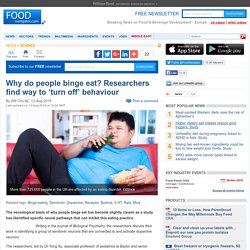
The researchers, led by Dr Yong Xu, associate professor of pediatrics at Baylor and senior author of the paper, specifically identified the serotonin 2C receptor and its precise role in suppressing binge eating. Binge-eating is the practice of consuming large amounts of food in a short time frame, and can form the basis of other eating disorders such as bulimia.
The scale of binge-eating Binge-eating is the practice of consuming large amounts of food in a short timeframe,©iStock A report commissioned by the UK eating disorder charity Beat, found that more than 725,000 people in the UK are affected by an eating disorder. The National Institute of Health and Clinical Excellence estimates around 11% of those affected by an eating disorder are male. Previous animal studies. Report: Millennial foodie trends vary based on gender, ethnicity. Dive Brief: Millennials make up a sizable portion of Americans who self-identify as foodies, but preferences among millennials and millennial foodies vary widely based on factors like gender, ethnicity, and geography, according to a recent study from youth marketing research firm Ypulse.
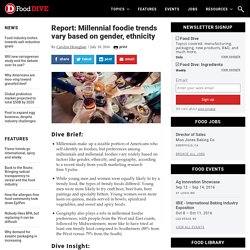
While young men and women were equally likely to try a trendy food, the types of trendy foods differed. Young men were more likely to try craft beer, beer bars, beer pairings and specialty bitters. L'impact des allégations et symboles de santé sur le comportement des consommateurs. Encourager les consommateurs à acheter des produits alimentaires plus sains est l'un des moyens d'améliorer le régime alimentaire des personnes.

Les allégations et symboles de santé mentionnés sur les emballages des aliments visent à aider le consommateur à choisir les plus sains, mais leur impact réel n’est pas tout à fait connu. Ainsi, le projet CLYMBOL (« L'impact des allégations et symboles de santé sur le comportement des consommateurs ») a été lancé pour analyser l'influence des allégations et symboles de santé. Blabla’plat : des « tutos » culinaires par et pour les étudiants. 1.

*Etude sur la santé des 15-25 ans en région languedoc-Roussillonwww.creaiorslr.fr British Journal of Nutrition - Consumers’ practical understanding of healthy food choices: a fake food experiment. Full Papers Innovative Techniques Consumers’ practical understanding of healthy food choices: a fake food experiment Sonja Möttelia1 c1, Carmen Kellera1, Michael Siegrista1, Jana Barbeya1 and Tamara Buchera2 a1 Consumer Behavior, Department of Health Sciences and Technology (D-HEST), ETH Zürich, Universitätstrasse 22, 8092 Zürich, Switzerland.
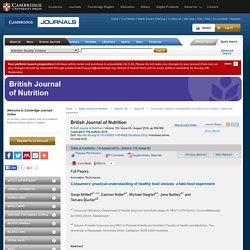
Identifying users of traditional and Internet-based resources for meal ideas: An association rule learning approach. <div class="msgBox" style="margin-top:10px;"><span class="errMsg"><div>JavaScript is disabled on your browser.

Please enable JavaScript to use all the features on this page. This page uses JavaScript to progressively load the article content as a user scrolls. Click the View full text link to bypass dynamically loaded article content. <a rel="nofollow" href=" full text</a></div></span></div><br /> Attitudes and behaviour towards convenience food and food waste in the United Kingdom.
Abstract Households in the UK discard much food.
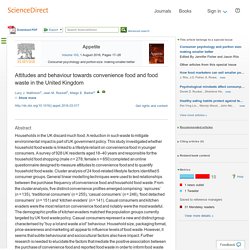
A reduction in such waste to mitigate environmental impact is part of UK government policy. This study investigated whether household food waste is linked to a lifestyle reliant on convenience food in younger consumers. A survey of 928 UK residents aged 18–40 years and responsible for the household food shopping (male n = 278; female n = 650) completed an online questionnaire designed to measure attitudes to convenience food and to quantify household food waste. Cluster analysis of 24 food-related lifestyle factors identified 5 consumer groups. Keywords. Appetite, Special issue: How can food pleasure drive healthy eating habits? Food attitudes and well-being: The role of culture. A University of Connecticut, Bousfield Psychology Building, 228, 406 Babbidge Road, U-1020, Storrs, CT, 06269, United Statesb University of Connecticut, Bousfield Psychology Building, 181, 406 Babbidge Road, U-1020, Storrs, CT, 06269, United Statesc Universidad de Costa Rica, Instituto de Investigaciones Psicológicas, 11501-2060, San Pedro De Montes De Oca, San José, Costa Rica Received 19 June 2015, Revised 7 April 2016, Accepted 18 May 2016, Available online 20 May 2016 Choose an option to locate/access this article: Check if you have access through your login credentials or your institution Check access Get rights and content Abstract.
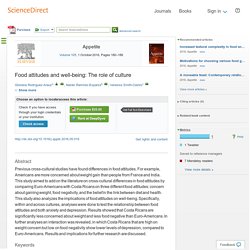
Motives of consumers following a vegan diet and their attitudes towards animal agriculture. Department of Agricultural and Food Marketing, University of Kassel, Steinstrasse 19, 37213 Witzenhausen, Germany Received 2 November 2015, Revised 16 June 2016, Accepted 29 June 2016, Available online 1 July 2016 Choose an option to locate/access this article: Check if you have access through your login credentials or your institution Check access. Organivore or organorexic? Examining the relationship between alternative food network engagement, disordered eating, and special diets. A Furman University, Department of Earth and Environmental Sciences, Greenville, SC, USAb Furman University, Department of Psychology, Greenville, SC, USA Received 28 January 2016, Revised 30 June 2016, Accepted 6 July 2016, Available online 7 July 2016 Choose an option to locate/access this article: Check if you have access through your login credentials or your institution Check access.
French consumers’ perceptions of nutrition and health claims: A psychosocial-anthropological approach. A Centre de Recherche en Psychologie, Cognition et Communication – EA 1285, Université de Bretagne Occidentale, 20 Rue Ducquesne, CS 93837, F-29238 Brest 03, Franceb Audencia Business School, 8 Route de la Jonelière, BP 31 222, F-44312 Nantes 03, Francec EHESS/CNRS, UMR 8177, Centre Edgar Morin, 22 Rue d’Athènes, F-75009 Paris, Franced LESMA, Audencia Business School, 8 Route de la Jonelière, BP 31 222, F-44312 Nantes 03, France Received 23 January 2016, Revised 13 May 2016, Accepted 21 June 2016, Available online 23 June 2016 Choose an option to locate/access this article: Check if you have access through your login credentials or your institution Check access.
Recent evidence on the effects of food store access on food choice and diet quality. Feature: Food Choices & Health Highlights: Food store access, particularly as measured by proximity, has a limited impact on food choices.Ninety percent of U.S. households shop for their groceries at supermarkets or supercenters, which generally carry wide varieties of both healthy and less healthy foods.Household and neighborhood resources, education, and taste preferences may be more important determinants of food choice than store proximity.
2016 - What is your ideal meal ? 2016 - What is your ideal meal ? Rapports/études/travaux (documents) ALISS - Note 2 "Manger dehors : représentation et pratiques" Communicating organic food quality in China: Consumer perceptions of organic products and the effect of environmental value priming. MAPP Centre – Research on Value Creation in the Food Sector, Aarhus University, Denmark Received 24 July 2015, Revised 30 January 2016, Accepted 2 February 2016, Available online 3 February 2016 Choose an option to locate/access this article: Check if you have access through your login credentials or your institution Check access doi:10.1016/j.foodqual.2016.02.003 Get rights and content Highlights We examine consumers’ product expectations of organic food in China. Further, we test the effect of environmental value priming on product expectations.
Organic labeling increases price and quality expectations but not health or taste. Nudging healthier food and beverage choices through salience and priming. Evidence from a systematic review. A Ehrenberg-Bass Institute for Marketing Science, University of South Australia, Adelaide, Australiab School of Population Health, Sansom Institute for Health Research, University of South Australia, Adelaide, Australiac Alliance for Research in Exercise, Nutrition and Activity (ARENA), Sansom Institute for Health Research, University of South Australia, Adelaide, Australia Received 17 July 2015, Revised 7 February 2016, Accepted 9 February 2016, Available online 15 February 2016 Choose an option to locate/access this article: Check if you have access through your login credentials or your institution.
Do we all perceive food-related wellbeing in the same way? Results from an exploratory cross-cultural study. A Sensometrics & Consumer Science, Instituto Polo Tecnológico de Pando, Facultad de Química, Universidad de la República, By Pass de Rutas 8 y 101 s/n, CP. 91000, Pando, Canelones, Uruguayb Sun Yat-sen University, Chinac MAPP Center, Department of Management, Aarhus University, Bartholins Alle 10, Aarhus 8000C, Denmarkd LUNAM Université, GROUPE ESA-GRAPPE, Francee GreenUP/CITAB-UP, DGAOT, Faculdade de Ciências da Universidade do Porto, Campus Agrário de Vairão, Portugalf GreenUP/CITAB-UP, DCeT, Universidade Aberta, Porto, Portugalg IRTA-Food Technology, XaRTA, Finca Camps i Armet, E-17121 Monells, Spainh U.S.
Army Natick RD&E Center, Natick, MA, USAi Brigham Young University, USAj IQ/Federal University of Rio de Janeiro, Rio de Janeiro, Brazilk Embrapa Food Technology, Av. das Américas, 29501, CEP 23.020-470, Rio de Janeiro, RJ, Brazil Received 7 December 2015, Revised 3 March 2016, Accepted 28 March 2016, Available online 30 March 2016 Choose an option to locate/access this article: Nudging health in food pantries. Grocery stores and cafeterias successfully nudge selection of target foods, but can this same strategy be used to encourage food pantry clients to select target healthful foods? In a new study published in the Journal of Public Health, Auburn University and Cornell University researchers found that product placement and packaging had a significant impact on what clients selected in a New York State food pantry. "Food pantries offer a unique opportunity to nudge those most at risk of hunger to select more nutrient-dense foods," explains lead author Norbert Wilson, PhD, Auburn University, "introducing easy low-cost target marketing strategies is a way to do this without taking away choice.
" The researchers observed a total of 443 clients visiting the pantry over 4 days. Del sabor al saber... Alimentación y dieta mediterránea en la España antigua: un cruce de culturas - Publicaciones Cajamar. Les jeunes de la Génération Y, connectés... Leurs parents impriment les recettes avant de cuisiner, eux préfèrent poser leur smartphone ou leur tablette avant de commencer une recette. C’est l’un des enseignements de la nouvelle étude Google, cofinancée par l'agence Mcgarrybowen et Kraft Foods, et qui analyse les comportements en cuisine des Millennials ou Génération Y, ces jeunes âgés de 25 à 34 ans, toujours plus connectés, même aux fourneaux. 59% des 25-34 ans s'aident de leur smartphone ou de leur tablette en cuisine et une grande majorité d’entre eux est à la recherche de conseils pratiques, qui constituent des requêtes extrêmement populaires sur les moteurs de recherche.
La convivailité et le partage sont d'autres aspects importants mis en avant par l'étude : 27 % des 25-34 ans souhaitent partager leur expérience avec leurs amis, conjoints ou enfants. Les calories des boissons sucrées : quel impact sur le comportement alimentaire des enfants ? Culinary choices: A sociopsychological perspective based on the concept of Distance to the Object. A Social Psychology Laboratory EA 351 (LAPPS EA 4386), Paris 8 University, 2 rue de la Liberté, Saint-Denis, Franceb Aix-Marseille Université, LPS EA 849, 13100 Aix-en-Provence, Francec APHM, Timone, Service d’Oncologie Médicale, 13385 Marseille, Franced Center for Food and Hospitality Research, Institut Paul Bocuse, Château du Vivier, BP 25, 69131 Ecully Cedex, Francee CNRS, UMR6265, INRA, UMR1324, Université de Bourgogne, Centre des Sciences du Goût et de l’Alimentation, F-21000 Dijon, France Received 1 May 2015, Revised 30 July 2015, Accepted 17 August 2015, Available online 28 August 2015 Choose an option to locate/access this article: Check if you have access through your login credentials or your institution Check access doi:10.1016/j.foodqual.2015.08.007 Get rights and content Highlights.
Overcoming consumer scepticism toward food labels: The role of multisensory experience. Global analysis of beverage consumption reveals key national differences. The results of the global analysis, published in PLOS ONE, finds that consumption of all three drinks categories is lowest in East Asia, while intakes of sugar-sweetened beverages (SSBs) is highest in the Caribbean where young (ages 20-39) were found to have the highest average consumption of 3.4 servings of sweetened beverages per day. Consumers want more ethical food. ‘Emerging middle class’ drive B-brand growth.
Longer school lunches lead to better food choices, say researchers. Elior : « Dans l’assiette de la génération Y : les nouvelles habitudes alimentaires des 18-30 ans » Americans support local food markets to feel part of something bigger than themselves. La restauration collective au travail conforte le modèle alimentaire français. Restauration collective au travail. Petit dejeuner des enfants. Baromètre de la perception des risques sanitaires 2015. Note de synthese N17 Barometre perception risques%20sanitaires 2015.
Not all Australians are obsessed with food, Roy Morgan Research. “Because we missed the way that we eat at the middle of the day:” Dietary acculturation and food routines among Dominican women. Attached to meat? (Un)Willingness and intentions to adopt a more plant-based diet. Le merguez-frites-bière, une alimentation de partage, politique et populaire. Les sacs réutilisables pousseraient à acheter bio. Actualités 2015 - Quelle est l’influence de la publicité sur les préférences alimentaires des enfants ? How are organic food prices affecting consumer behaviour? A review. Insects as food: Exploring cultural exposure and individual experience as determinants of acceptance. The green halo: Mechanisms and limits of the eco-label effect.
How are organic food prices affecting consumer behaviour? A review. Pre-sliced or do it yourself? – Determinants of schoolchildren’s acceptance of convenience fruits and vegetables. Les représentations sociales du « bien manger » Evolution des représentations sociales du bien manger. Guiding healthier food choice: systematic comparison of four front-of-pack labelling systems and their effect on judgements of product healthiness - Cambridge Journals Online.
British Journal of Nutrition - Eating out is different from eating at home among individuals who occasionally eat out. A cross-sectional study among middle-aged adults from eleven European countries - Cambridge Journals Online. “The food represents”: Barbadian foodways in the diaspora. Meat, beyond the plate. Data-driven hypotheses for understanding consumer willingness to adopt a more plant-based diet. Investigation of lifestyle choices of individuals following a vegan diet for health and ethical reasons. Making food labels social: The impact of colour of nutritional labels and injunctive norms on perceptions and choice of snack foods. Human contact imagined during the production process increases food naturalness perceptions. Novel methods to help develop healthier eating habits. A systematic review and meta-analysis. Workers’ Lunch Away from Home in the Paris of the Belle Epoque: The French Model of Meals as Norm and Practice.
Veille action pour de saines habitudes de vie - Affichage obligatoire des calories sur les menus : 3 fois plus de clients voient l’information et l’utilisent. Veille action pour de saines habitudes de vie - Eaux aromatisées et boissons aux fruits : beaucoup de parents pensent qu’il s’agit de boissons saines. Another Study Shows Kids Eating More Healthy Food at School, Throwing Less Food Away. Is There Still a French Eating Model? A Taxonomy of Eating Behaviors in Adults Living in the Paris Metropolitan Area in 2010. Traffic light labels may improve self-control.
Smaller plates may not lead teen girls to eat less, says study. Prospective associations between socio-economic status and dietary patterns in European children: the Identification and Prevention of Dietary- and Lifestyle-induced Health Effects in C. Children's and parents' health perception of different soft drinks. Yoghurt growth opportunities fuelled by global lifestyle differences, market research.
Maternal employment, acculturation, and time spent in food-related behaviors among Hispanic mothers in the United States. Evidence from the American Time Use Survey. Motives for consumer choice of traditional food and European food in mainland China. Associations between eating occasions and places of consumption among adults. Degree of food processing of household acquisition patterns in a Brazilian urban area is related to food buying preferences and perceived food environment. Appetite, Portion size. What information do consumers consider, and how do they look for it, when shopping for groceries online?
The impact of price reductions on individuals' choice of healthy meals away from home. Priming healthy eating. You can't prime all the people all of the time. Transition : une notion en sur-régime on Vimeo. Nutrition and health claims: Who is interested? An empirical analysis of consumer preferences in Italy. Chinese consumers’ understanding and use of a food nutrition label and their determinants. Reference amounts affect consumers’ healthfulness evaluation of foods. “Eating addiction”, rather than “food addiction”, better captures addictive-like eating behaviour. Why don't poor men eat fruit? Socioeconomic differences in motivations for fruit consumption.
Values, attitudes, and frequency of meat consumption. Predicting meat-reduced diet in Australians. “Snacks are not food”. Low-income, urban mothers' perceptions of feeding snacks to their preschool-aged children. Appetite, Social Influences on Eating. Explorations in cross-national comparison of food practices. Les cours de cuisine à l’école inciteraient les jeunes à choisir des aliments sains. Many in U.S. have poor nutrition, with the disabled doing worst. What do American babies eat? A lot depends on Mom's socioeconomic background. What Kids Around the World Eat for Breakfast.
Mobile apps can help raise consumer awareness says Mintel. Q&A Food and addictive behaviour. Food & Addiction. Halal ou pas ? Des tests bientôt disponibles en France. UK prefers vegetables over miracle health cure products, Canadean. Australia’s snacking habits revealed, Nielsen. Variety more than quantity of fruit and vegetable intake varies by socioeconomic status and financial hardship. Findings from older adults in the EPIC cohort. Social and individual determinants of adolescents' acceptance of novel healthy and cool snack products. Malbouffe : Les plats moins caloriques dans les fast-food ne connaissent pas le succès.